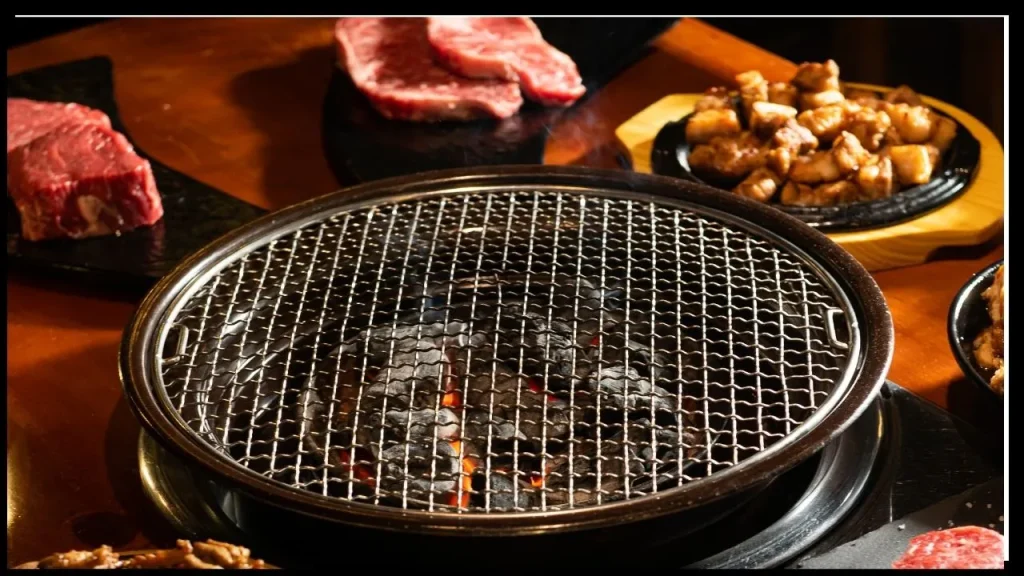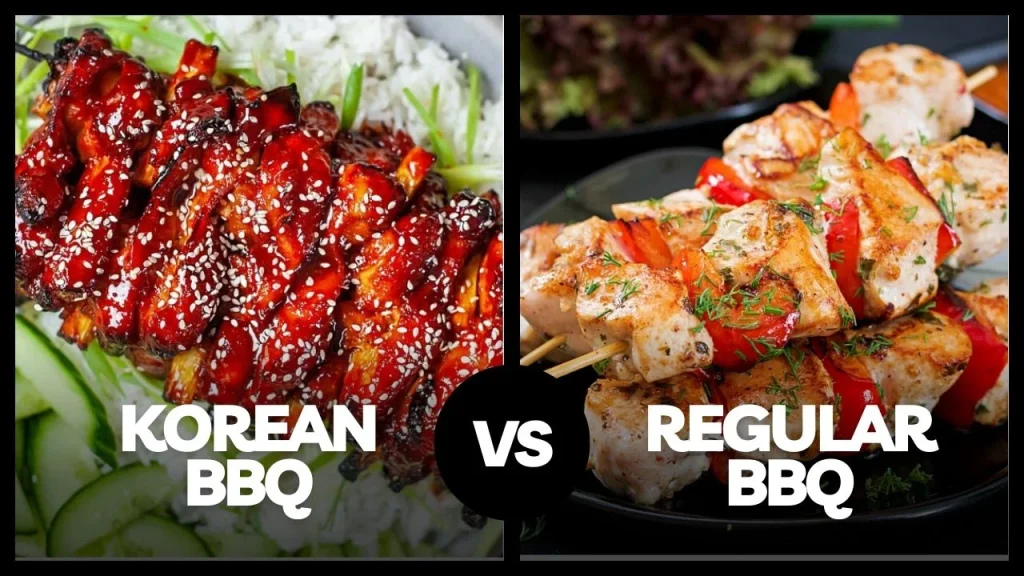Have you ever compared this?
Barbecue, or BBQ, is a kitchen tradition which is an emotion and loved throughout the globe. With its mutual style and rich marinades, Korean BBQ is the most loved dish. In contrast, traditional BBQ styles, including that of America, Australia, and South America, emphasize slow, smoky cuisine.
Here in this blog, we will look into the difference between Korean BBQ and normal BBQ from cooking style to taste to culture. As a foodie or a wandering eater, you will find that this guide makes it easy to learn to appreciate the uniqueness of Korean BBQ.
In this blog,
What is Korean BBQ?
- Key differences between Korean BBQ and Regular BBQ
- Health Benefits: Korean BBQ vs. Regular BBQ
- Conclusion
- FAQs
What is Korean BBQ?

Do you know exactly what Korean BBQ is? Read this:
Korean BBQ, or “gogi-gui“, refers to a classic Korean grilling technique where the consumers grill their food at the table on a charcoal or gas grill. They are usually served with a variety of banchan (side dishes), dipping sauces, and raw vegetables.
Different from Western BBQ, where slow cooking over a grill or smoker is preferred. Korean BBQ is a more social and interactive meal. It focuses on speedy grilling, strong marinades, and many flavors.
Key Differences Between Korean BBQ and Regular BBQ

Korean BBQ and regular BBQ are not the same, they differ in many ways.
They both offer distinct flavors, cooking methods, and dining experiences. While both revolve around grilling delicious meats, the way they are prepared, seasoned, and enjoyed varies significantly.
Whether you prefer the interactive, communal style of Korean BBQ or the slow-cooked, smoky richness of traditional BBQ, both have their own unique appeal.
Let’s differentiate between Korean meat and regular one now.
1. Cooking Technique
Korean BBQ
- Meat is grilled right at the table with a built-in grill (charcoal or gas).
- Diners cook their meat themselves, controlling the doneness according to taste.
- The process is very interactive and social.
- Typically used grills: flat-top grills, mesh grills, and stone plates.
Regular BBQ
- Prepared by a chef in a smoker, on a grill, or over an open flame.
- Preparation includes low and slow smoking, roasting or direct grilling.
- The emphasis is on preparing meats with smoke, heat, and time.
2. Types of Meat Used
Korean BBQ
- Thin cuts of meat are cooked fast, like bulgogi (marinated beef), galbi (short ribs), samgyeopsal (pork belly), and dak-galbi (spicy chicken).
- Meat is commonly marinated for added flavor.
Regular BBQ
- Bigger pieces of meat, including brisket, ribs, pulled pork, chicken wings, and sausages.
- Slow-cooked to bring juiciness and strong smoky flavors.
3. Marinades & Seasonings
Korean BBQ
- Wide use of soy sauce, sesame oil, garlic, ginger, and gochujang (Korean chili paste).
- Meats are pre-marinated to bring flavor before grilling.
- Dipping sauces such as ssamjang (spicy soybean paste) and sesame oil with salt and pepper.
Regular BBQ
Marinades and rubs differ according to region. Examples include:
- American BBQ: Dry rubs, smoky BBQ sauce, or vinegar-based marinades.
- Brazilian BBQ (Churrasco): Sea salt seasoning with little marinades.
- Australian BBQ: Simple salt, pepper, and herb-based marinades.
4. Side Dishes
Korean BBQ
Served with several banchan (small side dishes), including,
- Kimchi (fermented cabbage)
- Pickled radish and cucumbers
- Steamed egg (gyeran-jjim)
- Korean-style potato salad
- Lettuce wraps for wrapping grilled meats
Regular BBQ
Side dishes are more filling-based and center on complementing smoky tastes. Typical examples:
- Coleslaw
- Mac and cheese
- Baked beans
- Cornbread
- Grilled corn on the cob
5. Dining Experience & Culture
Korean BBQ
- Very social and interactive, with customers cooking their own meat.
- Shared plates promote conversation and communal feast.
- Traditional Korean BBQ restaurants tend to have exhaust vents above tables to clear out smoke.
Regular BBQ
- A more casual dining experience, where food is pre-cooked.
- Emphasizes individual portions over communal eating.
- Best served in BBQ restaurants, backyard barbecues, or smokehouses.
Suggested Reading: Top 10 Traditional Korean Foods You Must Try
Health Benefits: Korean BBQ vs. Regular BBQ
We should be healthier, right? But you know, BBQs are not just about being delicious, they can also be healthier.
Most people prefer Korean food right? But what makes people say Korean food is good? Take a look to this table below:
| Feature | Korean BBQ | Regular BBQ |
| Meat Cuts | Leaner cuts such as brisket, sirloin, and pork belly | Usually fattier cuts such as ribs, brisket, and pulled pork |
| Cooking Style | Fast grilling minimizes oil absorption | Slow cooking preserves more fats |
| Side Dishes | Fresh vegetables, fermented foods | Heavy carbs such as bread and potatoes |
| Sauces | Lighter, spicier, and umami-focused | Rich, frequently sweet BBQ sauces |
Korean BBQs leaner cuts of meat, lighter spices and probiotic side dishes such as kimchi, which supports gut health, make this more healthier.
So next time if you are searching for something healthier, try Korean BBQ.
Suggested Reading: What Is The Most Popular Flavor In Korea?
Highlights
- Barbecue or BBQ is a kitchen tradition that everyone loves.
- Korean BBQ and regular BBQ are different from each other for many factors including cooking style.
- They are mainly different for their side dishes.
- More than just being tasty, they have many health benefits too.
- Korean BBQ is different from others for its dining experience, side dishes.
- Mashisoyo is the best restaurant in Dubai for Korean dishes that has a variety of dishes on their menu.
Conclusion
Let’s wrap up!
Korean BBQ is distinct from traditional BBQ because of its interactive supper, strong marinades, and different side dishes. While traditional BBQ focuses on slow-cooked, smoky tastes, Korean BBQ adds a social and interactive flair to grilling.
If you are in Dubai, make sure to check out top-rated Korean BBQ restaurants for the real deal. Whether you like smokey American BBQ or miss the bold flavors of Korean dishes, both types of BBQ provide a special and tasty experience.
Mashisoyo, the top Korean restaurant in Dubai, is the best in town, offering mouthwatering dishes on their menu. You will get to taste traditional favorites like bulgogi, japchae, and kimchi pancakes and more. Each of our dishes are made with authentic flavors to provide a genuine Korean feast.
Is it a gathering? You can reserve your table earlier. But how? Go to Mashisoyo website’s home page, there you can see a small form, fill up that and secure your table. And you can even write a message or any preferences you want from us.
Looking for the best Korean food near you? Take a route to Mashisoyo.
FAQs
Is Korean BBQ healthier than regular BBQ?
Yes, Korean BBQ is considered as a healthier option when compared to regular BBQ. It features leaner cuts of Korean meat like bulgogi (marinated beef) and samgyeopsal (pork belly), which are grilled without excessive oils or heavy sauces. At Mashisoyo, one of Dubai’s top Korean restaurants, customers can enjoy high-quality, authentic Korean BBQ with balanced flavors and nutritious side dishes.
What makes Korean BBQ unique?
Korean BBQ has its own unique way of dining experience, where customers grill their own meats on the table. The meats are marinated in flavorful blends of soy sauce, garlic, sesame oil, and other seasonings, imparting a particular taste. Along with this, you can add various side dishes, such as kimchi, pickled radishes and steamed eggs to make a variety to the meal.
Can vegetarians enjoy Korean BBQ?
Yes, Korean BBQ is popular for its meat dishes, many restaurants, including Mashisoyo, also for vegetarians by offering grilled vegetables, tofu dishes, and other plant-based options. Mashisoyo’s menu features dishes like bibimbap, which can be customized with vegetables and tofu, providing a satisfying and authentic Korean dining experience for vegetarian guests.




